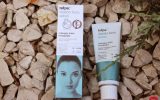Genetic code works like a template for our physical appearance: it defines our eyes, hair and even skin type. The genes are the ones to determine the skin type, which later often changes due to hormones, lifestyle and the facial treatments that the skin is exposed to on a daily basis. No matter what type the skin is, each one needs to be treated differently. Do you know what type you skin is? After reading this article you will be 100% sure.
Do you know that there are 6 skin types? Each one of them should be exposed to a particular set of treatments in order to keep it in a good condition. Only in this way the skin becomes flawless. Therefore, if you want to give your skin what it really needs, don’t treat it with the products your friends recommend. Why? Because the friend’s skin may be a lot different than your skin.
The profile of: OILY SKIN
You can tell that the skin is oily if:
- it’s shiny
- it produces too much sebum
- there are many breakouts and comedones
- the skin pores are enlarged
- the inflammations occur often
How to take care of oily skin?
First and foremost, such skin needs to be cleansed deeply. If your skin is affected by inflammations, don’t use aggressive peelings – better go for the enzymatic peels which application doesn’t require any rubbing. Additionally, oily skin should be made less shiny but not dehydrated. Otherwise, the skin will activate its defensive mechanisms and start producing even more sebum. Use delicate gel creams to replenish oily skin with water. They aren’t comedogenic so they don’t contribute to inflammation. Instead, such gel creams help you maintain a healthy look of skin and free you from this unwanted oily shine.
The profile of: COMBINATION SKIN
You can tell that the skin is combination if:
- you can see dry and oily skin areas
- it has shiny T-zone
- there is too much sebum on forehead and nose
- the cheeks are dehydrated and over-reactive
- the cheeks are often reddened
How to take care of combination skin?
Taking care of combination skin is a little bit tricky. Why so? Because there is no one cream that in a single step would satisfy the needs of over-reactive cheeks and oily T-zone. Therefore, you can go for two creams that will deal with the seborrhea, replenish skin with water and soothe the cheeks. If you think that your skin would use some hydration, try to find a good face serum enriched with hyaluronic acid. This is a lightweight and well-absorbing substance able to penetrate deeply into the skin to moisturize its multiple layers.
The profile of: DRY SKIN
You can tell that the skin is dry if:
- the cheeks and forehead are red
- the skin is hyper reactive
- the skin feels tight
- you can see dry skin patches
- the skin ages fast
How to take care of dry skin?
Basically, you should make sure that the skin is supplied with a daily portion of hydration. As well as this, you have to create an occlusive layer to prevent water from evaporating from the skin. This means that dry skin likes hyaluronic acid and natural vegetable oils that can be applied not only at bedtime but also in the morning, prior to makeup.
The profile of: COUPEROSE SKIN
You can tell that the skin is couperose if:
- it’s not resilient
- it doesn’t tolerate temperature fluctuations well
- is red
- it has spider veins
How to take care of couperose skin?
Broken capillaries are the most evident characteristic feature of couperose skin. If you want to soothe this skin type, you have to make the blood vessels stronger. How to do it? Keep them protected from the adverse weather conditions, apply sunscreens and try not to overheat the face. Luckily, you can choose among a wide array of creams that are responsible for strengthening the walls of capillaries.
The profile of: SENSITIVE SKIN
You can tell that the skin is sensitive if:
- is hyper-reactive, especially when it contact with skincare products
- doesn’t tolerate changes in the weather well
- is over-reactive to hard water
- the face itches, the skin flakes and becomes dry
- it’s often swollen
How to take care of sensitive skin?
If you want to take good care of sensitive skin, try finding a product that apart from hydrating, also soothes the skin and strengthens its defensive mechanisms. Also, avoid hard water and always protect the skin from freezing weather, the Sun and dry air.
The profile of: NORMAL SKIN
You can tell that the skin is normal if:
- it looks good
- is well-moisturized
- is smooth
- it doesn’t shine
- it isn’t red
How to take care of normal skin?
This skin type isn’t a common one. Although our skin is normal when we are kids, the hormones during the puberty period changes it to one of the above-mentioned types. However, if your skin type remains normal in your adulthood, try your best to maintain this state and treat it with high quality skincare products. Go for natural and organic products!


